In this article, let’s discuss about the GMAT Integrated Reasoning in detail,
Before getting into details of number of questions, question types etc. Let’s understand the GMAT Integrated reasoning.
I am pretty much sure below three questions would be going on your mind, before starting the preparation for GMAT Integrated Reasoning,
How important is GMAT IR?
What would be the good score in GMAT IR?
How and when should I prepare for GMAT IR?
How important is GMAT IR?
To answer the first question, let’s see little bit of history about GMAT Integrated Reasoning.
GMAT Integrated Reasoning was introduced somewhere in the month of August 2012, earlier it used to be another Essay (Issue) of half an hour. So they replaced it with Integrated Reasoning.
Integrated Reasoning is made up of 12 questions and the time limit is 30 minutes.
Now to answer “how important is GMAT Integrated Reasoning”,
If this question was asked couple of years ago, answer would have been, “may not be that important” because that time B – Schools didn’t had the enough data to understand “what would be good score in Integrated Reasoning”?
But now since it has been more than 4 years, answer would be “yes” it is very much important. Four years is a good time to have the data points to show what would be the good score
Lot of B- Schools started looking for the GMAT Integrated Reasoning scores.
Since GMAT Integrated Reasoning itself asks “Mini – case” studies, it helps B – Schools to understand the students reasoning ability.
A manager expected to deal with large numbers, representation using graphs, dealing multiple components etc.
GMAT Integrated Reasoning tests upon those skill sets.
So GMAT Integrated Reasoning is very important from student perspective.
Purpose of the IR Section
AdComs hardly use GMAT essays to judge candidates. Essay writing skills were anyways evaluated through application essays!
Most business schools now use case studies to teach some or even most topics
The old GMAT could not mirror two key aspects of case analysis, math – verbal integration and a flood of real world data.
The questions in the Integrated Reasoning section act as mini case analysis themselves.
The IR section assesses higher order reasoning skills among candidates.
Data Analysis and reasoning are essential skills for any manager. This gives AdComs slightly better insight into the managerial potential of a candidate
What would be the good score in GMAT IR?
This is actually a tricky question to answer,
Let me first project the last year trend in GMAT Integrated Reasoning scores and then I will let you decide on what would be a good score.
Integrated Reasoning is scored out of 1- 8 which intervals of one point increment.
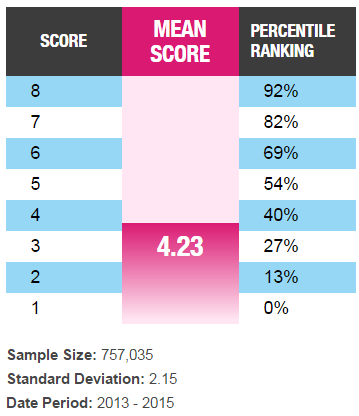
Above image shows the last three years (2013 – 2015) scoring trend in GMAT IR section among the students,
If you look at it, scoring 8(which is maximum) is 92nd percentile that means anybody who scores 8 would be among the top 8 percent of students.
Also scoring a 4 in IR is less than 50th percentile and according to the above image it is exactly 40th percentile.
So definitely everyone would like to score more than 5 to be in safer side.
If you ask me, a good score is something which lands you in a comfortable space when applying for top b – schools,
So certainly a GMAT score of 700 with Integrated Reasoning score 3, does not look very comfortable.
Also note that, the above details are for the period of 2013 – 2015.
I am sure these percentiles would definitely change in the coming years.
So I think now you have a fair idea what the score you should look for while preparing.
How and when should I prepare for GMAT Integrated Reasoning?
This is something a very important question, for someone who is very new to GMAT.
Let’s keep few things clear here first about GMAT IR,
Still GMAT Integrated Reasoning is not a part of the composite of 800.
Still Scoring a 700 or above (above 90th percentile) is more important than scoring above 90th percentile in GMAT Integrated Reasoning.
Getting an IR score of 8, doesn’t mean that you could score little less in the GMAT composite score of 800.
So one should first fix the GMAT composite score then move onto IR and AWA,
It’s again about prioritizing which is more important.
So if anybody starting the preparation for GMAT, his/her first focus should be on GMAT Verbal and Quant sections then move on to Integrated Reasoning.
Also IR doesn’t test anything which is totally different from GMAT Verbal and Quant sections,
Yes the question types are different and scoring is different but still the concepts are same. You no need to know anything new conceptual wise.
You have same Quant and verbal skills tested in IR section.
Also the best thing to do is whenever you sit to write a mock test, don’t skip any sections try to write the full 210 minutes test.
Most of the students skip AWA and IR while writing a mock test, which is not advisable.
Write the mock test along with IR section and analyze the IR section after the mock test in the same way you do for Quant and Verbal.
This will help you to get an idea about your strengths and weakness in GMAT IR.
One can use official IR questions to practice.
Also listing down the pros and cons of Integrated Reasoning section will help us to strategize it better.
Let’s list down the pros first,
GMAT Integrated Reasoning section is linear:
Unlike your Quant and Verbal sections in GMAT which is adaptive (the next set of questions are dependent on how well you have scored in the previous set of questions) IR is linear(questions are pre defined nothing going to change for the next set of questions even if you answer the current question wrong).
On-Screen Calculator:
You will be given an On-Screen calculator for Quant questions. If you are a good estimator of big values then actually you no need of on-screen calculator but otherwise you can use it for some big calculations if necessary.
Integrated Reasoning section also has Experimental questions:
Like your Quant and Verbal section, IR section also has 25% of the questions as experimental.
How this would be a positive?
Since it’s not an adaptive section, it’s better to guess and move on for questions which you find it hard, because there is a chance of it being experimental question.
Weight-age towards quant is more than verbal:
Most of the question types in Integrated Reasoning, inclined towards testing your Quant knowledge than verbal.
Especially question types Graphical interpretation and Table Analysis mostly they would test is Quant skills.
So anyone who loves numbers and graphs, this section would be a little bit easy for them.
Let’s see what would be the cons?
Some questions have more than one answers:
You would see Bi-polar questions (Yes –No , true – false) in GMAT Integrated Reasoning, mostly it would come with three (sub)questions, only if you answer all the three correct, you will be given the credit for the question. Even one of the bi-polar questions if you get wrong you won’t get the credit for it. We shall discuss this with an example in detail later.
Let’s have a rough look at it first,
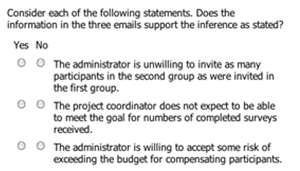
You can see in the above image, it’s just one question but it has three bi-polar questions to answer to it. Only if you get all three correct you will get a point.
Over concentrating on this might exhaust the mental energy:
One needs to be smart in Handling GMAT Integrated Reasoning section, because it easily exhausts the mental energy.
Typing an essay is far easier task than solving an Integrated Reasoning section.
Because for some questions like MSR (Multi Source Reasoning) you need to analyze the multiple tabs before coming to a conclusion for a question.
So here students should not focus on getting all the 12 questions correctly, one should be smart and chose questions based on their strengths and weakness.
That would be the pros and cons of a GMAT Integrated Reasoning section.
Now let’s see the question types in detail
The Integrated Reasoning section will basically have four parts:
Graphics Interpretation
Table Analysis
Two-part analysis
Multi-source reasoning
1).Graphical Interpretation:–
Generally, a pie chart, graph, flow-chart or some other graphic depiction is given and the candidate has to discern which data is useful to answer the question. Questions will be generally pertaining to Maths itself.
Special feature: There will be a calculator on the screen for some questions to assist students.
2). Table Analysis: –
A table will be provided. The candidate has to arrange or pick out selective data and use it for analysis. Questions will be generally pertaining to Maths or logical reasoning.
Special feature: Sorting the tables is allowed!
3).Two-part analysis:–
A problem statement is given, followed by some statements, each of which contains two columns. The candidate has to select an option in both the columns correctly to get the answer correct. Questions may be pertaining to Maths or critical reasoning.
Special feature: The candidate cannot guess, as the total number of possible answers here are not 5, but 25 (Owing to two answers!)
4).Multi-source reasoning: –
This bit of Integrated Reasoning is similar to Reading Comprehension. The candidate has to make sense out of multiple sources of text, such as an email exchange between two people etc., and then answer the questions that follow based on the multiple sources of data.
Multi Source Reasoning
Format
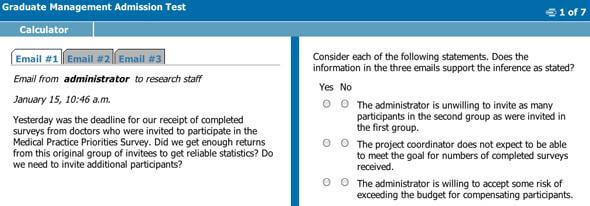
As you see in the above picture, you will have multiple tabs in this question type; one has to have a good idea about what each tab referring to before moving into the actual question.
MSR Working Procedure
-Create a summary or a map for the information in every tab. When you get a detail question, follow your map back to the relevant tab
-Always try to figure out two things
-Where the pieces of information are located
-How information given on one card influences or plays into information given on other cards
Be careful to answer exactly what is asked
Verify the answer to each question with concrete information on the cards
Example
Let’s take this below question (OG question) to understand MSR.
Article:
The expenses related to sponsoring a conference can be immense. An organization sponsoring a conference can recoup these expenses through registration fees and partnership with the host hotel. As part of the partnership, the host hotel sets aside a block of rooms for conference attendees, with rooms available at a slightly higher-than-normal rate.
While most conference attendees prefer to stay in the host hotel, they often follow an alternate strategy to avoid the extra cost of reserving a room within the block at the host hotel. Some attendees reserve rooms outside the host hotel — the ROHH strategy. Others reserve rooms outside the block — the ROB strategy.
Conference sponsors have succeeded in countering these strategies by increasing the conference registration fee by a fixed amount and then offering an equivalent registration fee discount to attendees who book rooms in the block. A study has shown that if this registration discount is equal to at least half the potential savings of an attendee’s particular cost-saving strategy, the attendee is much more likely to reserve a room within the block.
Weekend Conferences
Ten conferences are scheduled for the same weekend in City X. For each conference, the table lists the conference sponsor, the registration fee, the discounted registration fee (if any), the host hotel, the rate for rooms in the block at the host hotel, and the lowest rate for an available room in the host hotel during that same weekend. Conference attendees will require two nights lodging, and all room rates are per guest, per night, assuming two guests per room. The lowest rate for an available room in City X on this same weekend is $65.
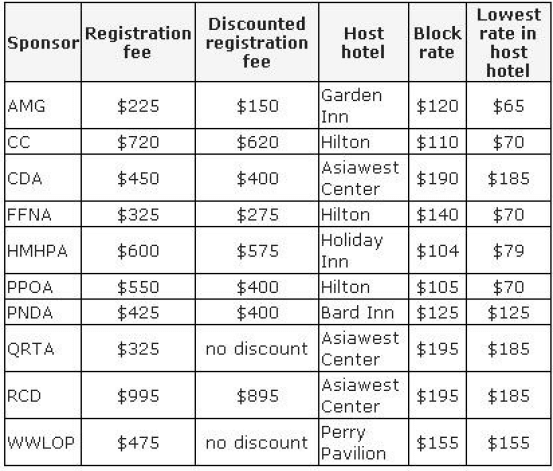
Start by taking good amount of time to understand the information in the tabs. There are two tabs here, one says “Article” and other says “Weekend Conferences”.
The first passage, “Article,” explains that hotel rooms at conference hotels can be more expensive than the typical rates for those rooms.
It then describes two strategies conference-goers can use: staying elsewhere (ROHH) and staying at the hotel but not booking through the conference (ROB). Finally, we learn that conferences offer discounts to those who stay within the block of allotted rooms, and that “if the discount is equal to at least half” of the savings of staying elsewhere, the conference-goer will stay within the block at the host hotel.
And there’s more, in the “Weekend Conferences” tab. This is Multi-Source reasoning at its best: plenty more information, both in written and table form. Continue to work deliberately, since there is important data in the passage: “attendees will require two nights lodging.” In other words, if an attendee saves $50 per night by staying elsewhere, that’s $100 over two nights.
Before attacking the questions, make sure you understand the table, as well.
The leftmost column lists conferences, while the next two columns list the registration fee and the registration fee if the attendee stays within the allotted block of rooms. The next columns name the host hotel, the rate within the block, and the rate outside of the block. The passage gives us another point of comparison, that the cheapest room for the ROHH strategy is $65–lower than almost all of the prices in the table.
You can take good 2 minutes to understand the tabs before getting into the actual questions
Question 1:
For each of the following sponsors, select Yes if an attendee of the sponsor’s conference would spend less money by employing the ROB strategy—paying the lowest possible room rate in the host hotel and paying the non discounted registration fee—than by reserving a room in the block. Otherwise, select No.
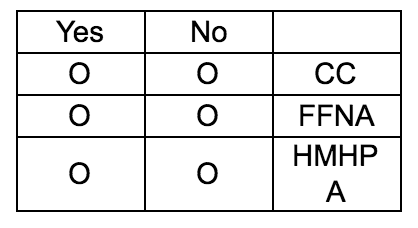
Explanation:
Here the question asks for three conferences, whether staying outside the block at the host hotel (the ROB strategy) is cheaper than staying in the block (and getting the registration discount).
Also remember that one has to get all three correct to get the credit of the question.
To determine that, consider the savings from each strategy.
For CC, the savings from the registration discount is $100. The savings from using the ROB strategy is $80 ($40 per night, paying $70 instead of $110). Thus, first one is NO, staying in the block is cheaper than employing the ROB strategy.
For FFNA, the registration discount is $50. The savings from ROB is $140 ($70 per night). This is YES, since staying outside the block is less expensive.
For HMHPA, the registration discount is $25. The savings from ROB is $50 ($25 per night). This again will be YES, since staying outside the block is less expensive.
So answer would be NO, YES and YES.
Question 2:
Assume that host hotels receive a reimbursement from the conference organizers for 25% of the block rate per night for each r unoccupied room in the conference block. For each of the following hotels, select Yes if, for at least one conference on the weekend listed, the hotel would lose room revenue if a room in the block is vacant because an attendee employed the ROB strategy. Otherwise, select No.
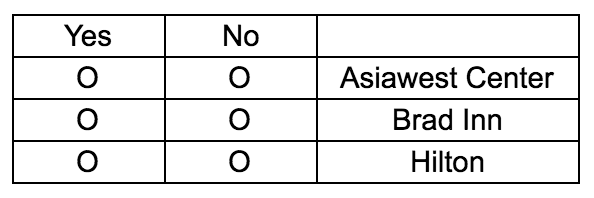
Explanation:
This particular question provides additional data: If a room in the block is vacant, the conference organizers pay the hotel 25% of the block rate. Of course, if an attendee uses the ROB strategy, the hotel is still renting a room, but at a different rate.
Start with the Asiawest Center. Note that Asiawest is hosting three conferences, and the question is asking whether the hotel would lose revenue if an attendee of any of the conferences used the ROB strategy. For CDA, the block rate is $190 and the lowest rate is $185. If an attendee uses ROB, the hotel earns $185 from the attendee and a reimbursement of 25% of $190 (nearly $50) from the conference. That’s better than renting the block room!
The same math applies to QRTA and RCD, where the ROB-using guest pays $185 and the conference organizers pay nearly $50.
Thus, first option is NO. Note that you didn’t have to do much math–approximation was sufficient. While 25% of $190 or $195 isn’t quite $50 (25% of $200), it doesn’t matter whether the reimbursement is $40, $48.75, or $57–the answer is the same.
Only one conference, PNDA, is at the Bard Inn. There the block rate and the lowest rate in the hotel are the same, so if a guest uses the ROB strategy, the hotel doesn’t lose money even if the conference doesn’t reimburse it. So second one is NO.
Three conferences are at the Hilton: CC, FFNA, and PPOA. For CC, if an attendee uses the ROB strategy, they pay $70, and the conference reimburses 25% of $110, or a bit more than $25. Thus, for that guest, the hotel earns a bit more than $95–a loss compared to the block rate. There’s no need to evaluate the other two conferences at the Hilton: So this is YES.
So here the answers are NO, NO and YES.
3. Let X denote the block rate of the host hotel for a particular conference, and let Y denote the lowest room rate available in the host hotel outside of the conference block. For a conference that requires a two-night hotel stay, which one of the following expressions represents the least amount of discount on the conference registration fee that, according to the article, would be sufficient to deter conference attendees from employing the ROB strategy in choosing accommodations?
X+Y2
X-Y2
X-Y
X+Y
2(X-Y)
Explanation:
This question is more to do with the abstract thinking. Recall from the article that if the registration discount is at least half of the possible savings of the ROB or ROHH strategies, attendees will stay within the block. Since X is the block rate and Y is the non-block rate, the savings per night from staying outside the block is X – Y. The savings for staying two nights outside the block is double that: 2(X-Y).
But the registration discount only needs to be half that. Divide by two, and the result is (X – Y), choice (C).
Two Part Analyses:
As you see in the below picture, you will be give a questions stub followed by a table where you have two columns (questions) and one more column with answer choices common for both the questions.
Best part about the two –part analysis is sometimes both the columns (questions) are linked, so one would be solving only one question still get the answer for both.
You have to get both correct to get the credit of the question.
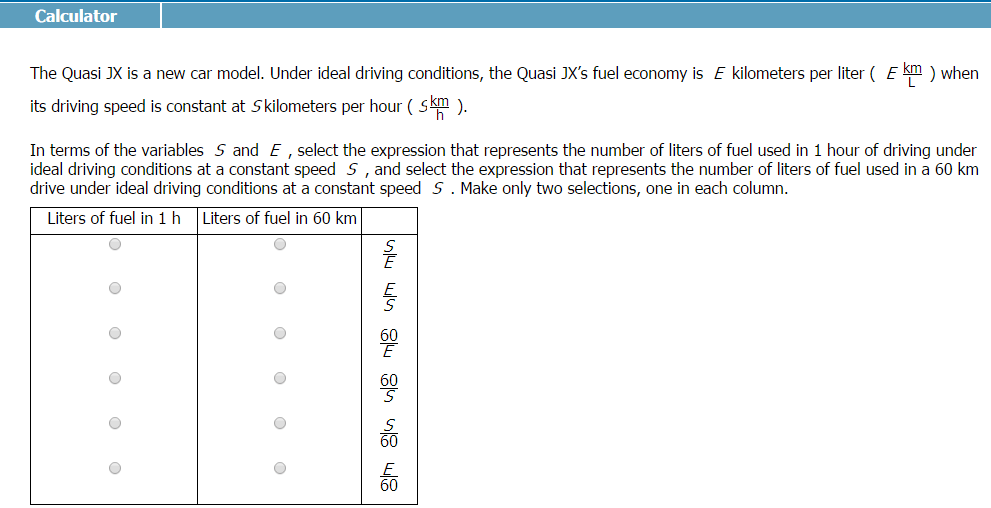
TPA Working Procedure
-Determine the relationship of the two questions
-For a quant TPA use strategies of plugging in and backsolving since all the answer options contain variables
-For a verbal TPA, read the entire prompt carefully and hold onto relevant information that helps to answer the questions
-Pay close attention to what must be true, could be true and what absolutely can’t be true
Example
Consider a right circular cylinder for which the following quantities are all numerically equal: the height, in meters; one-fourth of the volume, in cubic meters; the area of the circular base, in square meters.
In the table, select a value for the diameter of the circular base and a value for the height, where both are measured in meters, so that the two values are jointly consistent with the information provided. Make only two selections, one in each column
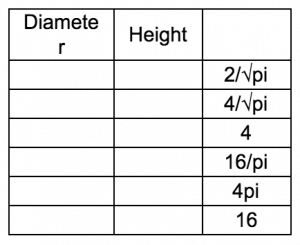
Explanation:
This question is easy to solve because it test you quant very directly,
To solve this question, one must know the Volume of the cylinder which is, pi * r2 * h
Given:
For what values the height, in meters; one-fourth of the volume, in cubic meters; the area of the circular base, in square meters are equal,
h = 1/4th of pi * r2 * h = pi * r2
Let h denote the height (in meters); and let r and d denote the radius (in meters) and diameter (in meters).
Let’s solve the First column, Infer that the volume of a right circular cylinder is equal to the area of its base times its height,
h = 1/4th of pi * r2 * h
¼ pi * r2 = h
r2 = 4/pi
r = 2 sqrt(pi)
So d = 4 sqrt(pi)
So answer is B for the first column.
Second column,
1/4th of pi * r2 * h = pi * r2
¼* h = 1
h = 4
So the answer is C for the second column.
Table Analysis:
Generally Table analysis questions are data heavy, so one should have a quick look at the tables and have a clear on the picture on the columns and rows.
Good thing about table analysis is they allow you to sort the columns and mostly it would be the bi-polar questions.
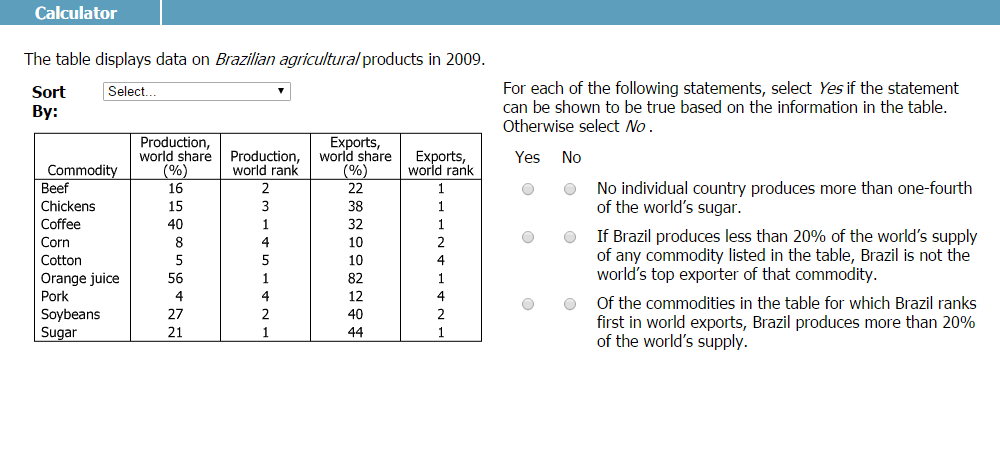
TA Working Procedure
-Figure out what kind of information is in each row and column
-Understand the nature of numbers in each column
-Do not confuse columns which contain a mix of absolute quantities and percents
-Pay close attention to the column labels
Example
Data
The table lists data on the 22 earthquakes of magnitude 7 or greater on the Richter scale during a recent year. Times are given in hours, minutes, and seconds on the 24-hour Greenwich Mean Time (GMT) clock and correspond to standard time at Greenwich, United Kingdom (UK). Latitude, measured in degrees, is 0 at the equator, increases from 0 to 90 proceeding northward to the North Pole, and decreases from 0 to —90 proceeding southward to the South Pole. Longitude, also measured in degrees, is 0 at Greenwich, UK, increases from 0 to 180 from west to east in the Eastern Hemisphere, and decreases from 0 to —180 from east to west in the Western Hemisphere.
For each of the following statements, select Yes if the statement is true based on the information provided, otherwise select No.
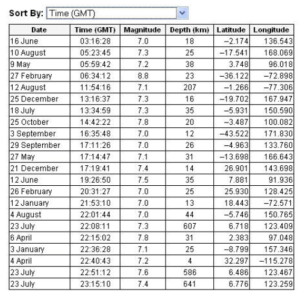
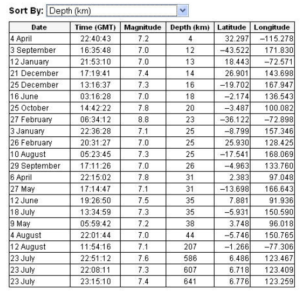
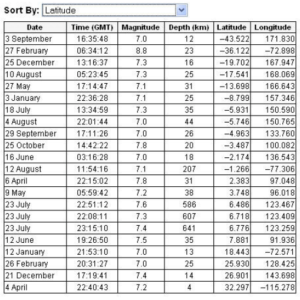

Explanation:
The first question asks whether,
“For the 22 earthquakes; the arithmetic mean of the depths is greater than the median of the depths.”
In mathematical terms:
Is Mean > Median?
The question asks us to compare mean and median. Our natural instinct will be to first calculate the mean and then the median.
But lets find out median first, because its easier(Remember you can sort the column here).
The median –>
Median is the value of the middle-most cell of depth column, when data points are arranged in ascending order.
In this dataset, there are 22 elements.
So middle most value = mean of 11th and 12th values
Median = =25.5.
Now let’s find the mean, you got to be smart don’t do any unnecessary calculations.
Don’t find mean by the standard approach, be smart here, knowing a small rule would help here,
Fundamental principle – In a series of all positive numbers, mean of the series is always greater than the sum of limited data divided by total # of data points in the set.
When we glance at the dataset, we find that the last value 641 is disproportionately high. This implies that mean of the all depths must be greater than 1/22 times 641. This equals to 1/22*(641) = 29.136 km. Now, 29.136 km itself is already greater than the median depth (25.5 km), so the actual mean of the depths must be greater than the median of the depths. So we could arrive at the answer without actually calculating the exact mean of the list.
So answer would be Yes.
Next two questions(statements) are much simpler.
Second question, given location is north of the equator provided that its latitude is positive. So you can sort the latitude column here. You can see that only 10 of the 22 earthquakes listed occurred at positive latitude, so fewer than half of the earthquakes occurred north of the equator. So the answer would be No.
Third question, to determine the number of earthquakes occurring between 10:00:00 and 20:00:00 GMT, you can sort the column on Time (GMT) and then count. The 9 earthquakes appearing in positions 5 through 13 of the sorted list meet the criterion, but 9 out 22 is less than half. So the answer is No.
Graphical Interpretation:
Graphs could be of multiple types like pie – chart, line graph, and column charts etc. Let’s try to list down all the different types of graphs.
Graphical Interpretation question is mostly be text followed by a blank which has a drop-down menu with options, you can see that in the below image.
Before solving it, one should open the options of drop-down menu and then solve it.
It avoids unnecessary calculations of the objects which are in the graph but not in the options.
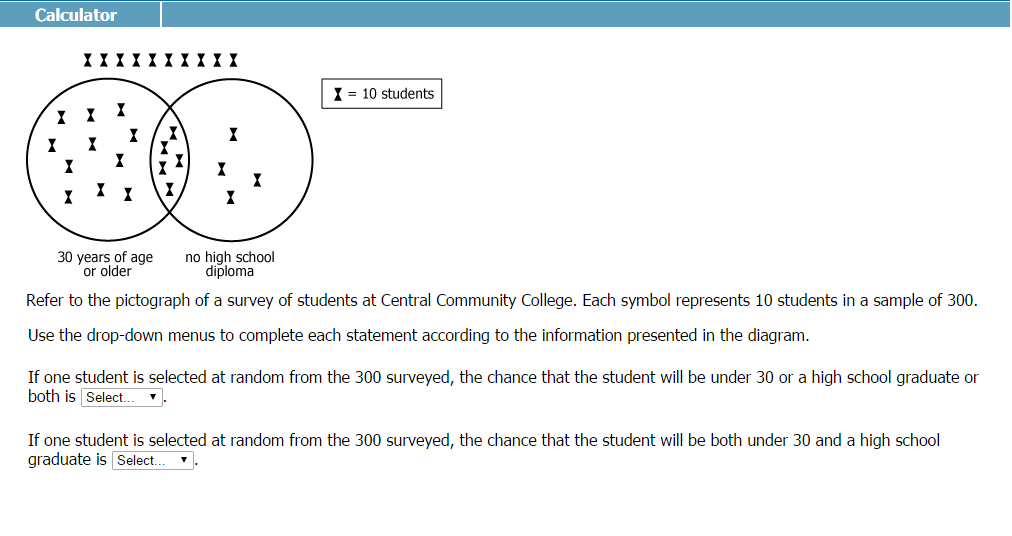
GI Working Procedure
– Analyze the graph/graphs. If there is more than one graph look for a linking factor between the two graphs
– Read the text accompanying the graph carefully. Pay attention to how the graph is labeled
– Estimate! You need not read the precise value on the graph if the value is between two ranges
– If you see words like ‘nearest to’ or ‘closest to’ then that is a clear invitation to estimate
PIE CHARTS
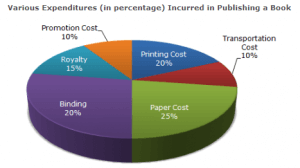
– Used to show the relative sizes of slices as proportions of a whole
– Can be either a percentage pie chart or a degree pie chart
– In a percentage pie the entire circle represents a total of 100% and in a degree pie the entire circle represents a total of 360 degrees
– Can show only one series of data. If you see two pie charts then they represent two separate series of data
COLUMN CHARTS
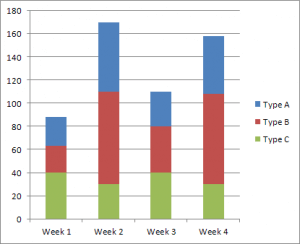
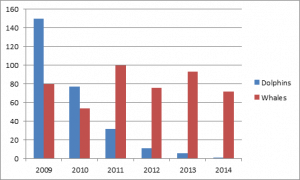
– Shows amount as heights and can be used to show trends over time
– Estimation is a key skill that you need to use here as you will have to read a value of a column which is between the gridlines
– Questions will deal with a percent increase or decrease from one time period to the next
LINE GRAPHS
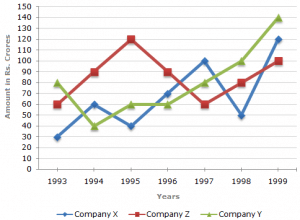
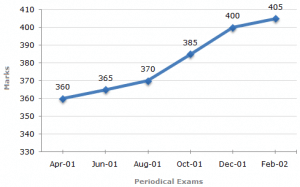
– Very similar to column charts but each value is shown as a floating dot rather than a column
– X axis almost always represents time and the Y axis represents a definite value or a percentage
– Line graphs are used to track changes over short and long periods of time
SCATTER PLOTS
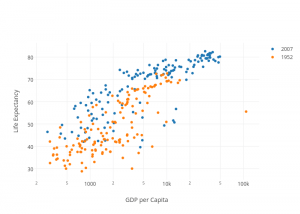
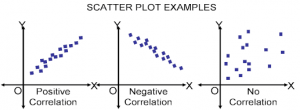
– Displays bi variate data i.e. data in which we measure two different variables for each participant
– Each individual (each car, each company) would be a single dot on the graph, and the graph would have as many dots as individuals surveyed or measured
– When the points on a scatter plot lie more or less in a straight line that is called correlation.
– When it’s a straight line with a positive slope, that’s positive correlation, and when it’s a negative slope, that’s negative correlation
BUBBLE CHARTS
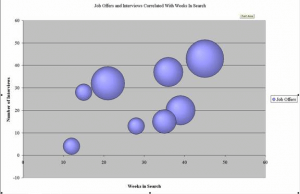
Very similar to scatter plots but instead of having two pieces of information we have three
Size of the bubble adds a third variable
Bubble charts provide a quick way to visually display what is going on with three different variables at once
Example:
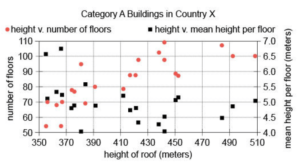
In Country X, a building is in Category A if it has a roof height of at least 350 meters. In the graph, each of the 22 Category A buildings is represented by two points arranged vertically: one representing the comparison of the height of the building’s roof to the number of floors (red circles), the other representing the comparison of the height of the building’s roof to the mean height per floor (black squares). Based on the given information, use the drop down menus to most accurately complete the following statements about Category A buildings in Country X.
The building with the greatest mean height per floor has a roof height between __________ metres.
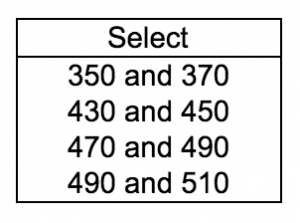
There is a ___________ correlation between the number of floors and the mean height per floor.
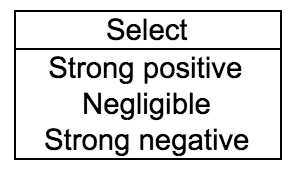
Explanation:
On some Graphics Interpretation questions, the graph will not be intuitive. In those cases, spend a little more time reading the labels on the graph and the introductory paragraph so that you can gain a thorough understanding of the data.
Identifying the units in the graph is very important, I would suggest write down the units in the scratch pad provided to you, so that you avoid careless errors.
In this case, the graph includes two dots–one red, one black–for each of several buildings. Each building has a height between 350 and 510 meters. That measurement is the x-axis.
There are two y-axes. On the left, we have “number of floors,” and each building has a red dot that reflects the number of floors given the building’s height.
For instance, the red dot is the far lower left tells us that a building roughly 355 meters high has approximately 53 floors.
The black dots reflect the “mean height per floor,” which is the y-axis on the right. The black dot that refers to that same ~355-meter-high building is near the top of the graph, indicating that that building’s mean height per floor is just above 6.5 meters.
The intro says there are 22 buildings. Thus, the graph contains 22 black dots and 22 red dots–one of each for each building.
First Blank asks you to identify the building with the greatest mean height per floor. Mean height per floor is the black dot, and the highest black dot is near the upper left corner of the graph, corresponding with a roof height of about 365 meters. Thus, the height of this building is between 350 and 370 meters. This a lot easier.
Second Blank refers to a concept that you may not be familiar with: correlation. There are three choices: strong negative, negligible, and strong positive.
If a correlation is positive, it means that when one attribute is high, the other is generally high, and vice versa.
When a correlation is negative, if one attribute is high, the other is low, and vice versa.
A negligible correlation refers to situations where there is no consistent relationship between the two attributes.
In this example, the correlation is strong negative. For most of the buildings with roof heights of 410 and above, the red dots and high and the black dots are low. For two of the shortest buildings, the black dots and high and the red dots are low. There are a few instances where both are in the middle, but in general, one attribute is high and the other is low.
So the answer would be strongly negative.
So that’s sums up the discussion of all the different question types which tested in GMAT IR.
Note that, I have used the official question as examples to show you the work around for each question type.
I hope you found this article useful while you prepare for GMAT.
All the best
Pro Tip: Curious about how to start off your own journey towards an awe-inspiring GMAT score ? Try out our free GMAT Online Trial course.

